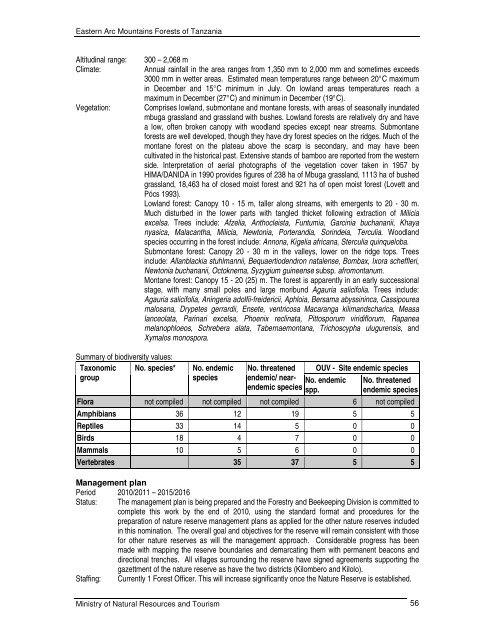eastern arc mountains forests of tanzania - Campaign for the ...
eastern arc mountains forests of tanzania - Campaign for the ...
eastern arc mountains forests of tanzania - Campaign for the ...
Create successful ePaper yourself
Turn your PDF publications into a flip-book with our unique Google optimized e-Paper software.
Eastern Arc Mountains Forests <strong>of</strong> Tanzania<br />
Altitudinal range: 300 – 2,068 m<br />
Climate: Annual rainfall in <strong>the</strong> area ranges from 1,350 mm to 2,000 mm and sometimes exceeds<br />
3000 mm in wetter areas. Estimated mean temperatures range between 20°C maximum<br />
in December and 15°C minimum in July. On lowland areas temperatures reach a<br />
maximum in December (27°C) and minimum in December (19°C).<br />
Vegetation: Comprises lowland, submontane and montane <strong><strong>for</strong>ests</strong>, with areas <strong>of</strong> seasonally inundated<br />
mbuga grassland and grassland with bushes. Lowland <strong><strong>for</strong>ests</strong> are relatively dry and have<br />
a low, <strong>of</strong>ten broken canopy with woodland species except near streams. Submontane<br />
<strong><strong>for</strong>ests</strong> are well developed, though <strong>the</strong>y have dry <strong>for</strong>est species on <strong>the</strong> ridges. Much <strong>of</strong> <strong>the</strong><br />
montane <strong>for</strong>est on <strong>the</strong> plateau above <strong>the</strong> scarp is secondary, and may have been<br />
cultivated in <strong>the</strong> historical past. Extensive stands <strong>of</strong> bamboo are reported from <strong>the</strong> western<br />
side. Interpretation <strong>of</strong> aerial photographs <strong>of</strong> <strong>the</strong> vegetation cover taken in 1957 by<br />
HIMA/DANIDA in 1990 provides figures <strong>of</strong> 238 ha <strong>of</strong> Mbuga grassland, 1113 ha <strong>of</strong> bushed<br />
grassland, 18,463 ha <strong>of</strong> closed moist <strong>for</strong>est and 921 ha <strong>of</strong> open moist <strong>for</strong>est (Lovett and<br />
Pócs 1993).<br />
Lowland <strong>for</strong>est: Canopy 10 - 15 m, taller along streams, with emergents to 20 - 30 m.<br />
Much disturbed in <strong>the</strong> lower parts with tangled thicket following extraction <strong>of</strong> Milicia<br />
excelsa. Trees include: Afzelia, Anthocleista, Funtumia, G<strong>arc</strong>inia buchananii, Khaya<br />
nyasica, Malacantha, Milicia, Newtonia, Porterandia, Sorindeia, Terculia. Woodland<br />
species occurring in <strong>the</strong> <strong>for</strong>est include: Annona, Kigelia africana, Sterculia quinqueloba.<br />
Submontane <strong>for</strong>est: Canopy 20 - 30 m in <strong>the</strong> valleys, lower on <strong>the</strong> ridge tops. Trees<br />
include: Allanblackia stuhlmannii, Bequaertiodendron natalense, Bombax, Ixora scheffleri,<br />
Newtonia buchananii, Octoknema, Syzygium guineense subsp. afromontanum.<br />
Montane <strong>for</strong>est: Canopy 15 - 20 (25) m. The <strong>for</strong>est is apparently in an early successional<br />
stage, with many small poles and large moribund Agauria salicifolia. Trees include:<br />
Agauria salicifolia, Aningeria adolfii-freidericii, Aphloia, Bersama abyssininca, Cassipourea<br />
malosana, Drypetes gerrardii, Ensete, ventricosa Macaranga kilimandscharica, Measa<br />
lanceolata, Parinari excelsa, Phoenix reclinata, Pittosporum viridiflorum, Rapanea<br />
melanophloeos, Schrebera alata, Tabernaemontana, Trichoscypha ulugurensis, and<br />
Xymalos monospora.<br />
Summary <strong>of</strong> biodiversity values:<br />
Taxonomic<br />
group<br />
No. species* No. endemic<br />
species<br />
No. threatened<br />
endemic/ near- No. endemic<br />
endemic species spp.<br />
OUV - Site endemic species<br />
No. threatened<br />
endemic species<br />
Flora not compiled not compiled not compiled 6 not compiled<br />
Amphibians 36 12 19 5 5<br />
Reptiles 33 14 5 0 0<br />
Birds 18 4 7 0 0<br />
Mammals 10 5 6 0 0<br />
Vertebrates 35 37 5 5<br />
Management plan<br />
Period 2010/2011 – 2015/2016<br />
Status: The management plan is being prepared and <strong>the</strong> Forestry and Beekeeping Division is committed to<br />
complete this work by <strong>the</strong> end <strong>of</strong> 2010, using <strong>the</strong> standard <strong>for</strong>mat and procedures <strong>for</strong> <strong>the</strong><br />
preparation <strong>of</strong> nature reserve management plans as applied <strong>for</strong> <strong>the</strong> o<strong>the</strong>r nature reserves included<br />
in this nomination. The overall goal and objectives <strong>for</strong> <strong>the</strong> reserve will remain consistent with those<br />
<strong>for</strong> o<strong>the</strong>r nature reserves as will <strong>the</strong> management approach. Considerable progress has been<br />
made with mapping <strong>the</strong> reserve boundaries and dem<strong>arc</strong>ating <strong>the</strong>m with permanent beacons and<br />
directional trenches. All villages surrounding <strong>the</strong> reserve have signed agreements supporting <strong>the</strong><br />
gazettment <strong>of</strong> <strong>the</strong> nature reserve as have <strong>the</strong> two districts (Kilombero and Kilolo).<br />
Staffing: Currently 1 Forest Officer. This will increase significantly once <strong>the</strong> Nature Reserve is established.<br />
Ministry <strong>of</strong> Natural Resources and Tourism 56


